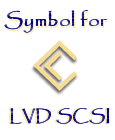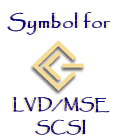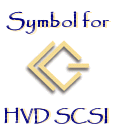|
SCSI Glossary
 Part 1 Q. | Part 1 A. | Part 2 Q.| Part 2 A. | Part 3 Q. | Part 3 A. | Part 4 Q.| Part 4 A.
Part 1 Q. | Part 1 A. | Part 2 Q.| Part 2 A. | Part 3 Q. | Part 3 A. | Part 4 Q.| Part 4 A.
Q. 79. Where can I find SCSI connector pinout information?
- Answer: The various SCSI connector pinouts can be found in the SCSI specifications in section 5 of the SPI documents. Many of the SCSI websites have the information in an easier to use format. Try 50-Conductor Pinout for 50-pin high density and centronics connectors or 68-Conductor Pinout for the 68-pin high density and VHDCI connectors. These pages not only have the SCSI connector pinouts, they also include the names of the SCSI signal on each pin and the correct selection of cable pairs on which to place the signal pairs in shielded external round cabling in order to correctly assemble a SCSI cable. Do not expect to find the cable wire color coding as many manufacturers of SCSI cable use different color codes.
Q. 80. Where can I find drawings or photos to help me identify the various SCSI connectors?
Q. 81. What is a SCSI expander?
- Answer: A SCSI expander is a device that allows the user to expand the capabilities of the SCSI bus for certain applications. These applications include mixing of single-ended and differential interfaces, extending cable lengths to greater distances, isolating bus segments, adding more devices than the usual 8 or 16 and dynamic reconfiguration of SCSI components.
Per Section 10 of the EPI document of the SCSI-3 specifications, Simple Expanders do not occupy a SCSI ID and are invisible to the protocols. Simple Expanders are "devices" in the SCSI sense. Bridging Expanders have SCSI IDs on all ports and participate in SCSI arbitration and messaging. They are "SCSI devices" in the SCSI sense.
Again per the EPI, there are homogeneous expanders and there are heterogeneous expanders. Homogeneous expanders have the same type of bus segment on both sides - in other words, they do not perform a bus conversion such as SE to HVD. Used to expand the total length of SCSI cabling allowed in the SCSI domain or to provide isolation between SCSI bus segments.
A heterogeneous expander has a different type of bus segment on both sides, such as a SE to HVD converter. They are used for signal conversion and provide isolation between bus segments. Any expander having the multimode LVD/MSE interface may become either a homogeneous or a heterogeneous expander.

Q. 82. Where can I find books on SCSI?
- Answer: The SCSI Trade Association has a list of "Good SCSI Reads". Making SCSI Work is written for the individual who needs to put SCSI systems together and make them work correctly and who needs a more thorough understanding of SCSI. Books by Ridge and Schmidt are written at a more technical level.
Q. 83. Where can I get official ANSI SCSI documentation?
- Answer: The published SCSI documents may be purchased from either of two sources:
- ANSI
11 West 42nd Street
13th Floor
New York, NY 10036
Sales Dept: (212) 642-4900
- IHS Global Engineering
Visit their website to locate the office nearest you and for a list of the SCSI documents they have available.
Q. 84. Where can I get documents on emerging SCSI specs?
Q. 85. Can I locate peripherals more than 25 meters (82 ft) from the host?
- Answer: The "old" differential (HVD) offered maximum SCSI cable lengths of 25 meters (82 ft). HVD was rendered obsolete in the SPI-3 document of SCSI-3. The current LVD SCSI offers 12 meter (40 ft) maximum cable lengths except in point to point applications where you may use up to 25 meters (82 ft). To extend these distances you need a SCSI expander. Some expanders extend the copper SCSI cabling distances two to four times the usual length. Some put the SCSI signals on coaxial or fiber optic cables to extend the distances to many miles.
Q. 86. Is there anything I can do if I need to locate a peripheral more than the SCSI recommended cable length from the host?
- Answer: There are several things you can do. Your choice depends on the distance you need and your budget. SCSI expanders called repeaters or RegeneratoR™ can increase copper SCSI cable distances by a factor of two or four. SCSI extenders convert the parallel SCSI signals to serial, place them on coaxial or fiber optic cable and then convert them back to parallel SCSI. These devices allow 300 feet to several miles of cable. Another choice is the use of a SCSI to fibre channel bridge, however, at the time of this writing this approach is expensive and problematic (refer to FAQ "Is Ultra 160 SCSI better than fibre channel?").

Q. 87. How can I locate SCSI backup devices in another building or another part of this building?
- Answer: If the same building location is within approximately 250 feet, SCSI repeaters or RegeneratoR™ will allow full data throughput over standard copper SCSI cabling. Beyond that you will need a SCSI extender that converts the parallel SCSI signals to serial, places them on coaxial or fiber optic cable and then converts them back to parallel SCSI signals. These extenders allow distances of 300 feet to several miles between devices. Another choice is the use of a SCSI to fibre channel bridge, however, at the time of this writing this approach is expensive and problematic (refer to FAQ "Is Ultra 160 SCSI better than fibre channel?").
Q. 88. What effect does SCSI cable impedance mismatches have and what are the symptoms?
- Answer: Any kind of impedance mismatches in the SCSI cabling, including device interfaces, terminators, adapters, connectors, or cabling can cause SCSI signals to be reflected back to the source. These reflected signals cannot be distinguished from the actual SCSI signals but, of course, are not what is expected by the receiving device. This results in requests for "SCSI re-sends" and in extreme cases, shutdown of the SCSI bus. These problems are exacerbated by faster SCSI signaling.
- Symptoms vary from the system recognizing that drives are there, but not being able to read or write to them, to reading (or writing) to some drives but not to all of them, all the way to bus shutdown. Sometimes the symptoms can be eliminated by changing SCSI cable length by five or six feet. This changes the time that reflected signals arrive and may actually eliminate the symptoms. If this works, and you are getting the data throughput that you expect, leave it. The system will run reliably until you change something - like adding a new drive or changing cable length.
- To actually eliminate the problem, you must make sure you have correct termination (use active terminators on single-ended systems), reduce the number of adapters and connectors to a minimum, pay attention to the impedance of all the cables (ribbon as well as round, shielded) in the system, make sure that you are leaving sufficient cabling between all peripherals and observe all the cautions referenced in the SCSI specifications.
Q. 89. What causes impedance mismatches in SCSI subsystems and what can I do to reduce them?
- Answer: Impedance mismatches occur in a SCSI bus segment at any place where the SCSI signals encounter an impedance change. This can occur at the host adapter or peripheral device interface, the terminators, connectors, adapters or any change from one cable to another. It is important to reduce the number of connectors to a minimum. Also pay attention to the characteristic impedance of each of the SCSI cables, whether they are ribbon or round, shielded cables. Even cables from the same manufacturer may have different impedance. To reduce the effect of stubs, first reduce them to a minimum in terms of length, then space peripherals a minimum of 12 inches (300 mm) apart on the cabling. Reflections caused by impedance mismatches become increasingly important with each increase in SCSI data throughput.

Q. 90. I have read that I should not try to save money when purchasing SCSI cables? Why?
- Answer: Cabling is arguably the most important factor in getting a SCSI subsystem running reliably and at maximum data throughput, so their importance cannot be overemphasized.
- Also, many SCSI cables are built by cable people, not SCSI people.
- They do not understand that SCSI cables are rf transmission lines and consequently some of the shortcuts they take to save manufacturing cost cause problems for the installer. SCSI is, at a minimum, a 50-wire bus.
- We have found so-called SCSI cables with 50-pin connectors on each end, but only 37 or even as few as 25 wires in the cable. This cable may work on a single-ended system if they are very short and the bus is running Slow SCSI, but they absolutely will not work in an HVD or LVD system and can cause problems in a single-ended system that are very difficult to trouble shoot.
- Also, leaving wires out of the cable changes the characteristic impedance of the cable, increases crosstalk and reduces the noise rejection capability of the system.
- To be on the safe side, buy only cables that are termed "differential SCSI cables" as they will work on either single-ended or differential systems. This does not assure, however, that they are properly assembled cables. It is very important that SCSI signal pairs be assigned to cable pairs and that certain signal pairs be assigned to cable pairs in the core of the cable with control signals on the second layer and data signals on the outer layer.
- This emphasizes the importance of buying SCSI cables from a supplier that uses quality components in his cable assemblies including cable that is designed to meet the SCSI specs which includes characteristic impedance, twisted pairs and shielding and knows which signal pairs to assign to which cable pairs.
Q. 91. Must I use twisted pairs in my ribbon cables or round SCSI cabling?
- Answer: The SCSI specifications strongly recommend the use of twisted pairs in both ribbon and round, shielded SCSI cables. Twisted pairs help in noise rejection and in maintaining the characteristic impedance of the cable and become more significant with increases in SCSI data throughput. Although cabling without twisted pairs will work in many applications, why take the chance. Problems caused by cables are very difficult and time consuming to trouble shoot.

Q. 92. What are the rules for SCSI terminators? What kind of terminators should I use and where should I put them?
- Answer: Each SCSI bus segment must be terminated at the two extreme ends. There must be two terminators, and only two terminators. On an internal ribbon cable the first and last connector on the ribbon cable must have a terminated device (host adapter, peripheral or expander) or a terminator plugged into it. On external round, shielded cabling, the last device must be terminated. If the last device does not have built in terminators, you can use a pass through terminator or, if the last device is in an enclosure with two SCSI connectors, you can use one connector for connection to the bus and the second connector for a terminator.
Passive single-ended terminators should be used only for Slow SCSI systems (5 Mbytes/sec max). Use active single-ended terminators for any bus that runs faster than 5 Mbytes/sec. HVD SCSI has no need for anything other than passive (HVD) terminators. LVD terminators are different than multimode (LVD/MSE) terminators. If you are plugging a multimode LVD device into a single-ended bus, a single-ended terminator is sufficient. Note that single-ended and differential terminators are different and HVD terminators are different than LVD terminators.
When you are placing a Narrow device or devices on a Wide SCSI bus that already has some Wide peripherals attached, you must be very careful that the upper byte of the Wide bus is properly terminated. Refer to FAQ on attaching Narrow devices to a Wide bus for more information.
Q. 93. I had some problems with a SCSI system that I seemed to cure by placing a third terminator on the bus. This violates SCSI terminator rules. Why did it seem to work?
- Answer: Adding the third terminator simply masked some other cable or terminator problems. If the system works reliably and at the data throughput you expect, go ahead and use it. It will very likely be reliable until you add another peripheral or change a cable length when the problem may very well reappear. It would be best to eliminate the source of the problem.
Q. 94. How do I assign SCSI IDs to various devices on the bus?
- Answer: IDs are assigned to devices through software or by setting hardware jumpers or switches. A given ID may be assigned to only one device in the SCSI domain. Regardless if the bus is a Wide or a Narrow bus, ID 07 has the highest priority and the SCSI host adapter normally is assigned to it. ID priority order from highest to lowest is 07, 06, 05, 04, 03, 02, 01, 00, 15, 14, ..., 09, 08. If you are placing Narrow devices along with Wide devices on a Wide bus, it is best to assign only IDs in the range of 07 to 00 if you can, because Narrow devices cannot recognize or exchange data with a device in the range of 15 to 08. The order in which IDs are assigned makes no difference and whether the devices are internal or external mount has no significance. Some operating systems do prefer that hard drives be at IDs 00 or 01 or CDs at ID 02.
In most home or small computer systems, you need not pay much attention to priority assignments, but if you have very fast hard drives assigned to high IDs and they are very busy, they can "hog" the bus and keep slower devices assigned to lower priority IDs from ever getting control of the bus. SCSI "fairness" is designed to combat this potential problem.
Remember that peripherals with the 80-pin SCA connector are designed to have their ID assigned by the backplane. If you want to use such a peripheral in a cabled SCSI system, you need an adapter that converts the 80-pin connector to a 68-pin (or 50-pin) and also brings out the power and ID assignment pins.
Q. 95. What is the priorty sequence of SCSI IDs?
- Answer: SCSI ID 07 has the highest priority regardless of whether the bus is Wide or Narrow SCSI. The host adapter is normally assigned ID 07. The order of priority from highest to lowest is 07, 06, 05, 04, 03, 02, 01, 00, 15, 14, ..., 09, 08. Narrow SCSI uses only the IDs from 07 to 00.

Q. 96. In what order do SCSI IDs have to be assigned?
- Answer: SCSI IDs do not have to be assigned in any particular order. The host adapter is normally assigned to ID 07 because it has the highest priority. Probably the most important thing to remember is that a given ID may be assigned only to one peripheral. If you are placing Narrow devices along with Wide devices on a Wide bus, it is best to assign only IDs in the range of 07 to 00 if you can, because Narrow devices cannot recognize or exchange data with a device in the range of 15 to 08. The order in which IDs are assigned makes no difference and whether the devices are mounted internally or externally has no significance. Some operating systems do prefer that hard drives be at IDs 00 or 01 or CDs at ID 02.
Q. 97. What is a SCSI "domain"?
- Answer: From the EPI document of SCSI-3: "A SCSI domain is a logical bus with at least one bus segment, at least one initiator, and at least one target. Domains with multiple bus segments are enabled through the use of bus expanders. Domains consist of the set of SCSI devices that are addressable from an initiator or target. Wide domains are limited to a maximum of 16 initiators and/or targets without the use of bridging expanders. Narrow domains are limited to a maximum of 8 initiators and/or targets without the use of bridging expanders."
In most cases, this means all the peripherals, expanders, terminators and cabling connected to one SCSI host adapter. Also refer to the FAQ "What is a bus segment" for related information.
Q. 98. What is a SCSI bus "segment"?
- Answer: From the EPI document of SCSI-3:
- "A SCSI bus segment consists of all the conductors and connectors required to attain signal line continuity between every driver, receiver, and two terminators for each signal. It is not necessary that a SCSI bus segment contain any initiators or targets but it has at least two devices attached. Drivers and receivers may be part of expanders as well as part of initiators and targets."
In practice, a SCSI bus segment is the cabling and devices (if any) between two terminators, including the terminators. A SCSI domain may consist of one or more bus segments.
Q. 99. What is a "device"?
- Answer: From the EPI document of SCSI-3: "Devices include targets, initiators and bus expanders. The term "SCSI device" is limited to targets and initiators."

Q. 100. What is a "stub"?
- Answer: A stub is an unterminated section of transmission line. The SPI-3 document of SCSI-3 defines a stub as: "Any electrical path connected to the bus that is not part of the bus path".
- An example of a stub on a drive enclosure that is externally mounted is the short length of ribbon cable between the drive's connector and the connector on the outside of the drive enclosure. This stub may not be longer than 0.1m (4 inches) on a single-ended or LVD bus or 0.2 m (8 inches) on a HVD bus. Even the conductive paths on a drive's pcb from the SCSI connector to the electronics is a stub. Stubs are unavoidable and should be kept to a minimum length. Stubs tend to accumulate, so peripherals should be separated from one another on the cabling. It is best to equally space peripherals over the length of a SCSI bus segment. As a minimum, drives should be separated by at least a foot of cabling.
Q. 100. What is "SCAM"?
- Answer: SCAM stands for SCSI Configured Auto-Matically. The last specification for SCAM is found in the SCSI-3 SPI-2 document in Annex B. It is an optional protocol designed to reduce problems with the configuration of SCSI IDs on single-user systems. It is obsoleted in SPI-3.
Q. 101. Does it hurt to have more than one device supplying term power?
- Answer: It normally does no harm to have more than one device supplying term power (TERMPWR). In fact, it is very helpful in systems with long SCSI cables to prevent voltage "droop" caused by IR loses through the cable or in systems that mix many Wide and Narrow SCSI devices. It is best that TERMPWR be supplied from all the initiators, expanders and device enclosures using only a single source per bus segment per enclosure. Theoretically, having too much TERMPWR current available (could be up to 32 Amps with 16 devices sourcing term power) could cause things to melt in an unusual defect situation.
Q. 102. I have a hard disk connected to the PCMCIA host adapter card in my laptop but it does not work. What is wrong?
- Answer: Although the SCSI specifications require that the host adapter provide power for the terminators, many PCMCIA and PC-Card host adapters do not include it. Maybe it has something to do with battery life, the space available or heat dissipation, but it is a problem. To make your system run, you have to provide term power from a source other than the host adapter. Many devices have a jumper option to provide termination power.
Q. 103. Next to the connector on some SCSI devices I have noticed various diamond-shaped symbols. What do they mean?
- Answer: The SPI-2 document of SCSI defines four icons, one for each type of SCSI meant to be placed near a SCSI port to indicate what type of SCSI the port is using. The icon may be used alone or with the text describing the port, such as "SCSI LVD". These are the icons:
Part 1 Q. | Part 1 A. | Part 2 Q.| Part 2 A. | Part 3 Q. | Part 3 A. | Part 4 Q.| Part 4 A.

|








